Complete Solutions to Subjective Type of chapter SALT ANALYSIS of Class 11 book with complete answers and questions
| Class 11 | CHEMISTRY |
| Chapter | SALT ANALYSIS |
| GRB PUBLICATION | Subjective Type |
| Number Of Questions | 69 |
| Academic Year | 2023-24 |
`[Fe(H_(2)O)_(6)]SO_(4).H_(2)O overset(Delta)rarr` Residue `(X) +Y uarr +Z uarr` Residue (X) was treated with HCI followed by `H_(2)S` gas yielding yellowish white turbidity (A). When gas (Y) is passed through `H_(2)S(aq)`, same yellowish white turbidity (A) is obtained. Find the atomic mass of (A).
View Solution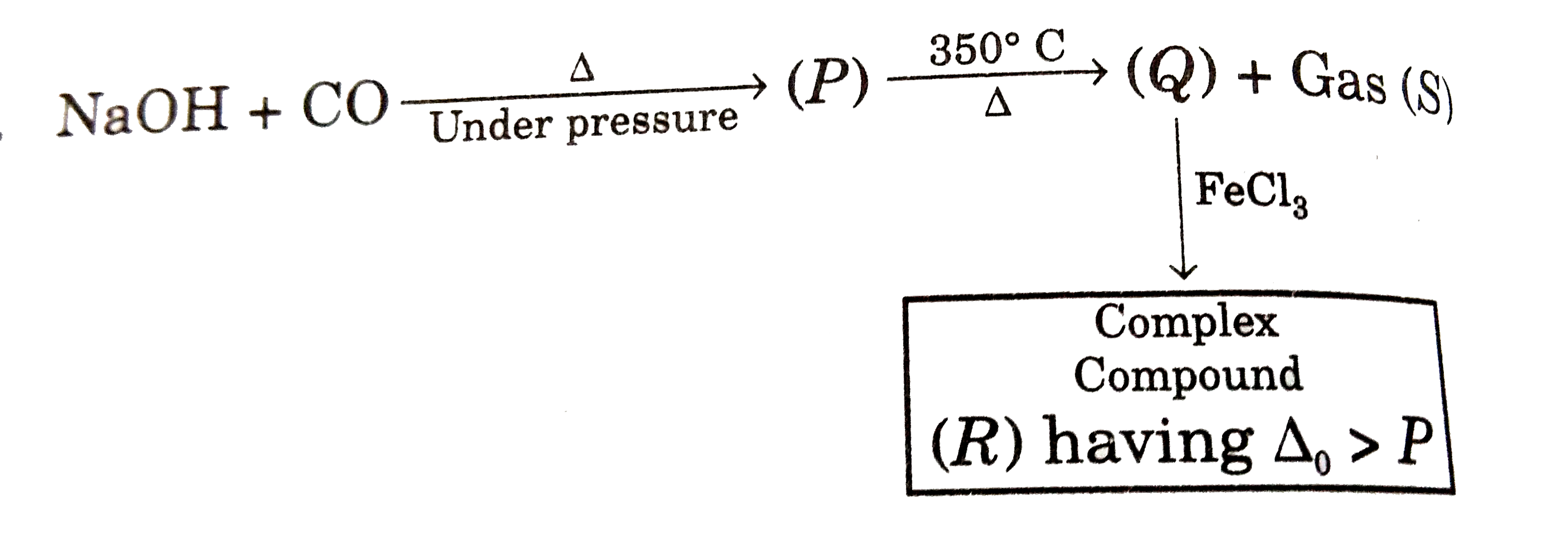
Find the number of correct statements.
(a) R has octahedral geometry.
(b) `overset(III)(Fe)` is `d^(2)sp^(3)` hybridised in R
R is paramagnetic
(d) R shows optiocal isomerism
(e) R shows geometrical isomerism
(f) Gas (S) is colourless
(g) Gas (S) has bond order of 1
(h) Gas (S) is monoatomic.
If total 3 statements are correct, write your answer as 003.
View Solution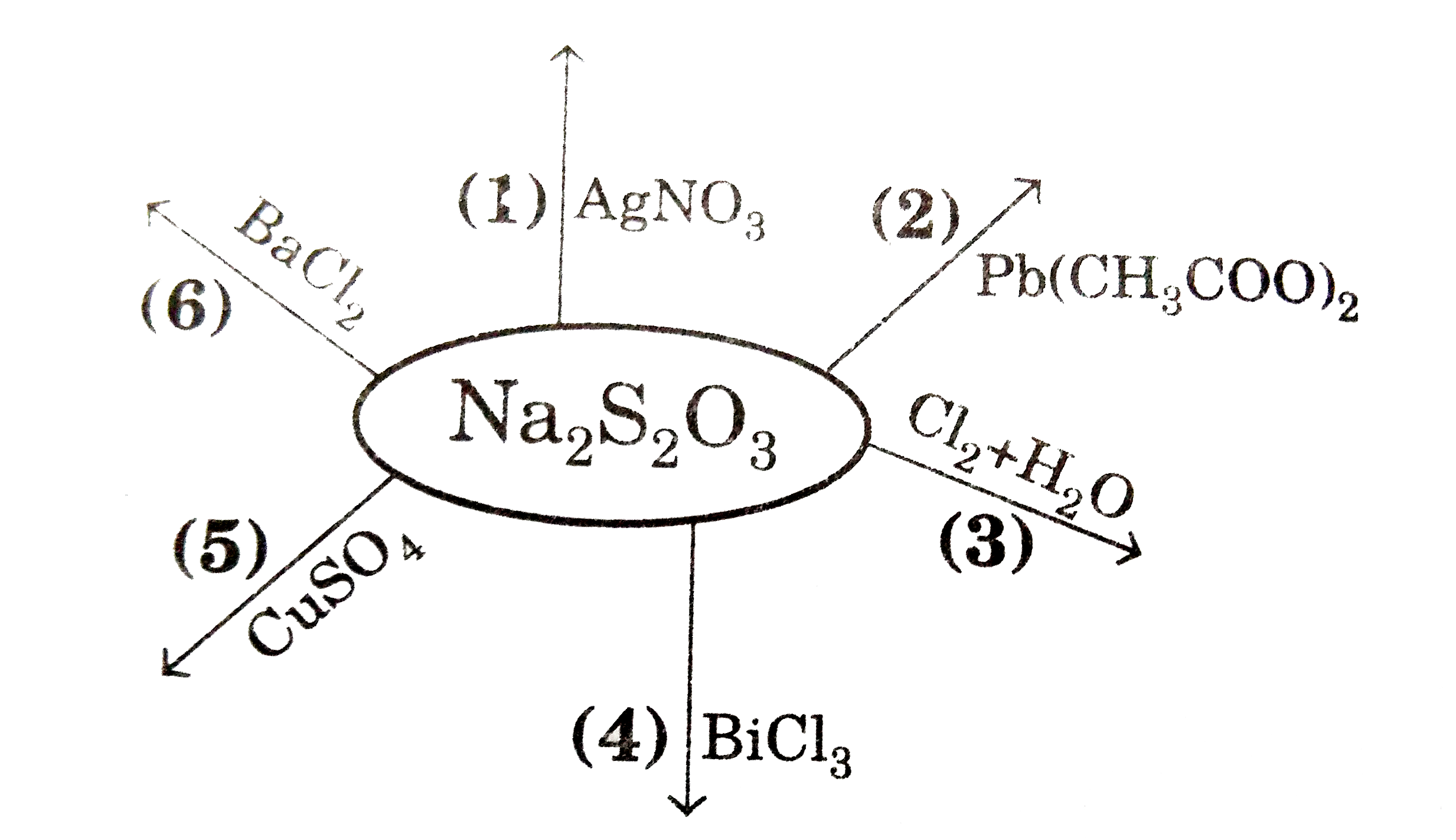
Which of the above mentioned reactions would yield white precipitate which on standing converts into black precipitate?
View SolutionFind the number of yellow coloured water insoluble compound.
`{:(PbI_(2),PbCrO_(4),KI,NaI),(Ag_(2)CrO_(4),BaCrO_(4),K_(2)CrO_(4),(NH_(4))_(3)PO_(4).12MoO_(3)),(HgO,AgI,AgCI,):}`
View Solution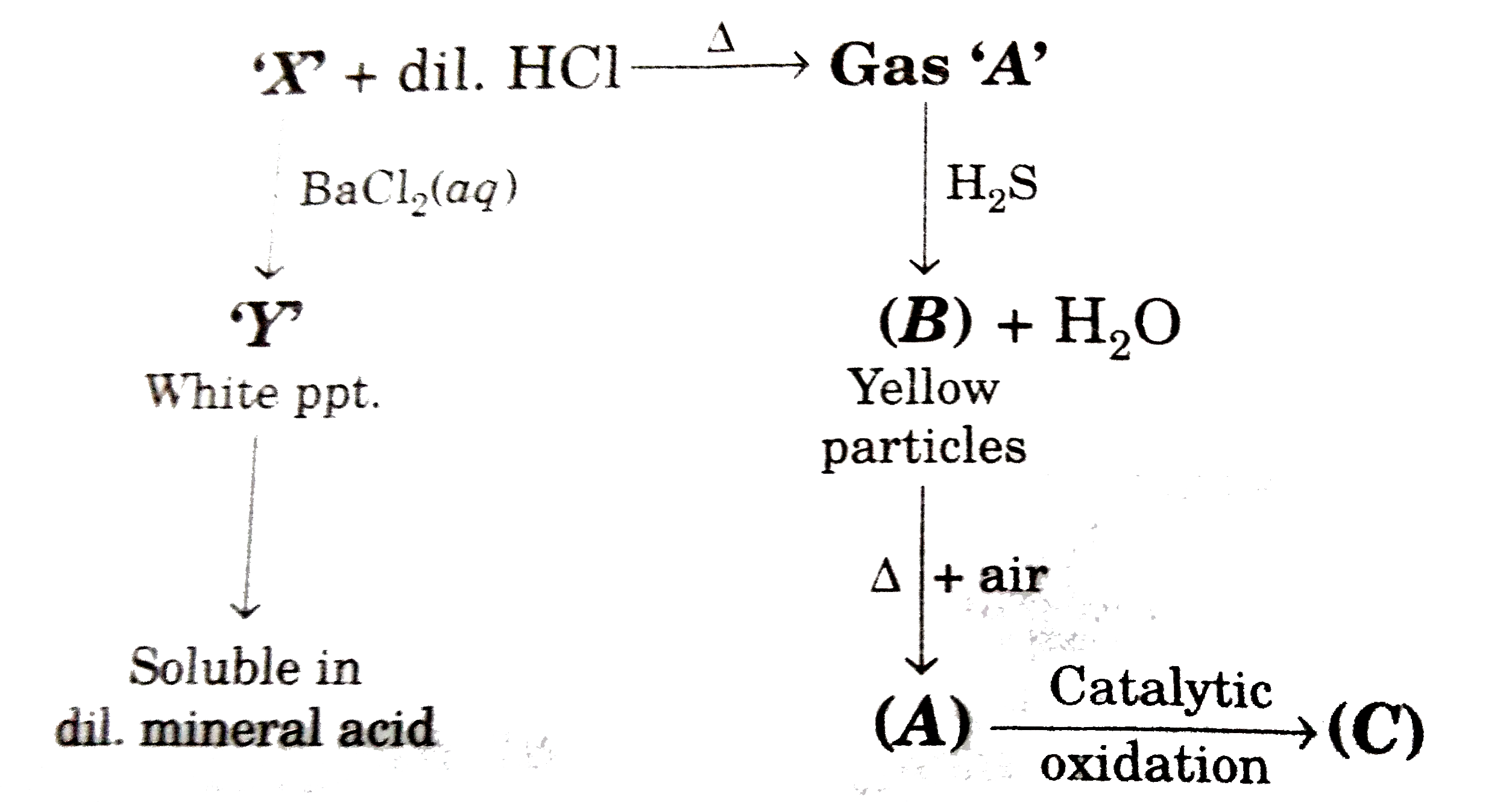
Find the sum of number of `p pi - p pi` and `p pi - d pi` bonds in trimer of C.
View Solution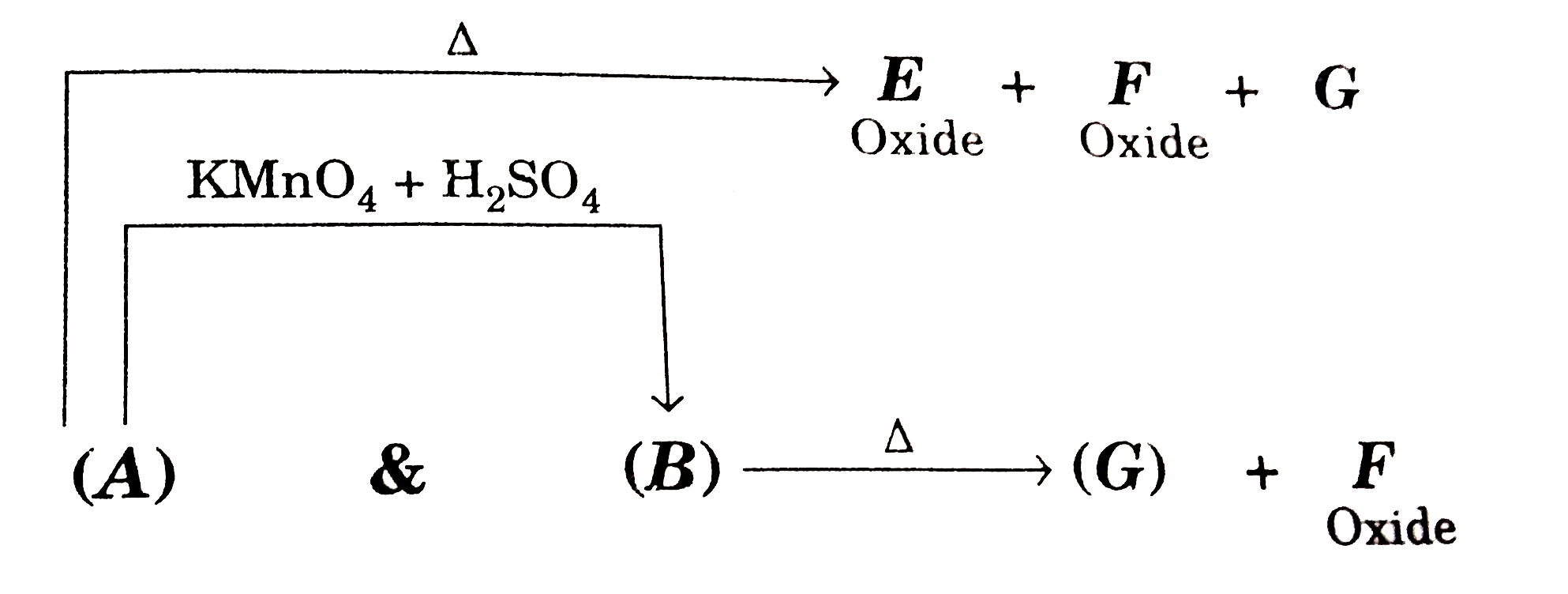
E and F are two different oxides of sulphur. Compound A and B will give ppt. with how many of the following compound?
`BaCI_(2),KCN,H_(2)SO_(4),HCi,HCN,Hg(NO_(3))_(2),SrCI_(2),Pb(CH_(3)COO)_(2),Pb(NO_(3))_(2)`
View SolutionAn alcohol (A) on treatment with conc. `H_(2)SO_(4)` gave an alkene (B). The compound (B), on reacting with `Br_(2)` water and subsequent dehydrobomination with `NaNH_(2)` produced a compound (C). The compound (C) with dil. `H_(2)SO_(4)` in presence (D) can also be obtained by oxidation of A by acifified `KMnO_(4)` or from dry heating of calcium acetate. Calculate the mass of `0.1` mol of D in gms. Round off your answer to next nearest integer.
View SolutionFind the number of reagent (s) which form white ppt. with `CO_(3)^(2-)` ion.
`BaCI_(2),CuSO_(4),HgCI_(2),Pb(CH_(3)COO)_(2),CaCI_(2)`
View SolutionFind the number of reagent (s) which oxidizes `HCO_(3)^(-)` ion solution:
`MnO_(4)^(-)//H^(+),Cr_(2)O_(7)^(2-)//H^(+), CI_(2)` water, `Br_(2)` water, `I_(2)` water
View SolutionFind the number of carbonates having `K_(sp)` value greater than `Li_(2)CO_(3)`
`Na_(2)CO_(3),K_(2)CO_(3),Rb_(2)CO_(3),Cs_(2)CO_(3)`
View SolutionChromyl chloride test can be given by how many of the following compounds easily?

View Solution`underset("Salt of iron")((X)) overset(Na_(2)S_(2)O_(3))rarr underset("Violet complex")((Y)) rarr underset("Green solution")((Z))`
Write oxidation number of Fe in (X) as first digit, (Y) as second digit, (Z) as third digit in OMR.
View SolutionFind the number of sulphide compounds which are not soluble in hot and dil. `HNO_(3)` but soluble in aqua regia
`Ag_(2)S,PbS,HgS,CdS`
View SolutionFind the number of carbonate precipitates which are white in colour
`PbCO_(3),3HgO,HgCO_(3),Hg_(2)CO_(3),CuCO_(3).Cu(OH)_(2),BaCO_(3)`
View Solution`FeO.Cr_(2)O_(3)+Na_(2)O_(2)rarr A +B +Na_(2)O`
`A + H_(2)O rarr underset("Red-brown ppt")(NaOH)+(C)`
`B +H_(2)O rarr underset("Yellow")((D)) +Na^(+)`
`(D) +2H^(+) rarr underset("Orange")((E))+H_(2)O`
Find the sum of peroxy linkages in A,B,C,D and E.
View SolutionFind the number of correct statements about `NH_(3)`.
(a) Basic gas
(b) Turns red litmus to blue litmus
(c) Gives white dense fumes with HCI
(d) Gives brown ppt. with Nessler's reagent
(e) Gives deep blue colour with `CuSO_(4)` solution with passed in excess
(f) Gives deep blue colour with `NiCI_(2)` solution when passed in excess
View SolutionHow many metal cations get precipitated, when `(NH_(4))_(2)S` solution is added into the aqueous solutions of the following cations?
`Ag^(+),Cu^(2+),Cr^(3+),Mn^(2+),Zn^(2+),Bi^(3+)`
View SolutionTotal number of following reagents, which can be used to distinguish with visile change between `SO_(2)` and `CO_(2)` gases:
`FeCI_(3)`-solution, `Br_(2)`-water, `CI_(2)`-wate, `H_(2)O_(2), (KMnO_(4)+H_(2)SO_(4))`, (strach-`IO_(3)^(-)),(K_(2)Cr_(2)O_(7)+H_(2)SO_(4)),Ca(OH)_(2)`
View SolutionWhich of the following acidic radicals produce coloured volatile product with conc. `H_(2)SO_(4)`?
`NO_(2)^(-),NO_(3)^(-),Br^(-),I^(-),CI^(-),S_(2)O_(3)^(2-),B_(3)^(3-),CrO_(4)^(2-)`
View SolutionFind out the total number of reagents(s) which gives white turbidity with `H_(2)S//Na_(2)S`:
`FeCI_(3),HNO_(3),H_(2)SO_(3),HCI,Ca(OH)_(2),(KMnO_(4)+H_(2)SO_(4)),H_(2)O_(2)`
View SolutionFind the number of salt(s) give(s) white coloured precipitate when treated with KI.
`Bi(NO_(3))_(3),Pb(CH_(3)COO)_(2), AgNO_(3),, HgCI_(2), Hg_(2)(NO_(3))_(2)`
View SolutionHow many of the substrates would produce `H_(2)S` when subjected to hydrolysis?
`Cr_(2)S_(3),AI_(2)S_(3),BaS,P_(4)S_(10),PSCI_(3),Na_(2)S`
View SolutionFind the number of radicals with cannot form white coloured precipitate with `K_(4)[fe(CN)_(6)]`
`Fe^(+3),Fe^(+2),Cu^(+2),Zn^(+2),Ca^(+2)`
View SolutionHow many of the following gases are characterized by `BOTH` colour and a distinctive odour?
`CI_(2),CH_(4),NO_(2)`
View Solution`Cu^(2+)+KCN` (in excess) `rarr` soluble complex (X). How many statements are correct regarding complex (X)?
(a) The central atom has the co-ordination number of 6
(b) The central atom has the co-ordination number of 4
The complex is square planar
(d) The complex is diamagnetic
(e) The complex is paramagnetic
View Solution`BiCI_(3) overset(KI)rarr` Black ppt. `(M) overset("excess" KI)rarr` Soluble complex (N) Find the number of moles of `I^(-)` ions involved for the formation of one mole of (N).
View Solution`Sn^(2+)` and `Sn^(4+)` can be distinguished by how many of the following methods?
(a) By passing `H_(2)S` in their solution (in acidic medium)
(b) By addition of `NaOH` in their solution
(c) By addition of excess `NaOH` in their solution
(d) By addition of dil. `HCI` in their solution
(e) By addition of `HgCI_(2)` solution in their solution
View SolutionFind total number of conditions is which oxidation of `Fe^(+2)(aq)` ions to iron (III) takes places:
(a) On exposure to air.
(b) On addition of conc. `HNO_(3)`
(c) On reaction with `SnCI_(2)`
(d) On reaction with `H_(2)O_(2)`
(e) On reaction with `MnO_(4)^(-)//H^(+)`
(f) On reaction with `KI`
(g) On reaction with `Cr_(2)O_(7)^(2-)//H^(+)`
View SolutionConsider the following list or reagents: Acidified `K_(2)Cr_(2)O_(7)`, alkaline `KMnO_(4),CuSO_(4),H_(2)O_(2),CI_(2),O_(3),FeCI_(3),HNO_(3)` and `Na_(2)S_(2)O_(3)`. The total number of reagents that can oxidise aqueous iodide to iodine is:
View SolutionAmong `PbS, CuS, HgS, MnS, Ag_(2)S,NiS,CoS,Bi_(2)S_(3)`, and `SnS_(2)` the total number of BLACK coloured sulphides is:
View SolutionHow many of the following gives green ppt.?
(a) `CrCI_(3)+NaOH rarr`
(b) `CrCI_(3)+"excess" NaOH rarr`
(c) `NiCI_(2)+"excess" NaOH rarr`
(d) `NiCI_(2)+"excess" NH_(4)OH rarr`
(e) `Hg_(2)^(2+) +KI rarr`
View SolutionWhen calamine is heated then a product (A) is formed then find the total number of correct options for compound (A):
(a) Compound (A) is white in cold conditions.
(b) Compound (A) is yellow in hot conditions.
(c) Compound (A) is called philosopher's wool.
(d) Compound (A) when combined with `CoO`, then compound (B) is formed and colour of new compound (B) is green
(e) Compound (B) is called Rinmann's green
View Solution`NaNO_(3) overset(500^(@)C)rarr (A)+(B)`
`(A) overset(800^(@)C)rarr (C)+(D)+(E)`
Find the number of correct statements:
(a) Compound (B) is paramagnetic in nature
(b) Compound (B) when undergoes dimerisation the dimer product is diamagnetic in nature
(c) Bond order of compound (B) is two
(d) (D) is `N_(2)` gas
(e) Compound (B) and (E) are same gas
View Solution`underset(("Dark purple almost black"))((A)) overset(Delta)rarr underset(("Green"))((B))+underset(("Black"))((C))+(D)`
Find the number of correct statements:
(a) Compound B is `K_(2)MnO_(4)`
(b) Compound C is `MnO_(2)`
(c) Compound D is `O_(2)`
(d) Compound B is paramagnetic in nature
(e) Compound D has two unpaired electrons in bonding molecular orbital
View SolutionTotal number of compounds that undero disproportionation redox reaction on heating
`MnO_(2),HOCI,H_(3)PO_(3),HNO_(2),CrO_(5),HCIO_(3)`
View SolutionOn strong heating of `H_(3)PO_(4)` and `H_(3)BO_(3)` sum of oxidation number of P and B in the final producy obtained is:
View SolutionFind the number of reagent(s) which form white ppt. with `CO_(3)^(2-)` ion.
`BaCI_(2),CuSO_(4),HgCI_(2),Pb(CH_(3)COO)_(2),CaCI_(2)`
View SolutionFind the number of reagent(s) which oxidized `HCO_(3)^(-)` ion wolution.
`MnO_(4)^(-)//H^(+),Cr_(2)O_(7)^(2-)//H^(+),CI_(2)`-water, `Br_(2)`-water, `I_(2)`-water
View SolutionHow many of the following reagents can be used to distinguish between `SO_(2)` and `CO_(2)`?
`Ca(OH)_(2)`, (strach `+KIO_(3)),(K_(2)Cr_(2)O_(7)+H_(2)SO_(4)),(KMnO_(4)+H_(2)SO_(4)),Ba(OH)_(2),FeCI_(3),Zn[Fe(CN)_(5)(NO)]`
View SolutionThe total number of reagents that are used to distinguish between sulphide and bisulphie acidic radical are: Litmus paper, `AgNO_(3),Pb(OAc)_(2),CaCI_(2),SrCI_(2),BaCI_(2),(K_(2)Cr_(2)O_(7)+H_(2)SO_(4)),(KMnO_(4)+H_(2)SO_(4))`
View SolutionHow many of following elements get disproportionated in strongly alkaline medium solution? `S,Ne,P,H,CI,F,O,N`
View SolutionFind the total number of metals, which makes a thin protective layer of its oxide on treatment with conc. `HNO_(3)`
`Al,Zn,Sn,Cu,Pt,Cr,Au,Ag`
View SolutionThe total number of anionic species which give coloured gas with conc. `H_(2)SO_(4)`are:
`CO_(3)^(2-),HCO_(3)^(-),SO_(3)^(2-),NO_(3)^(-),S_(2)O_(3)^(2-),CH_(3)COO^(-),SO_(4)^(2-)`.
View SolutionAmong the following find the total number of incorrect statement(s):
(a) `BO_(3)^(3-),PO_(4)^(3-),F^(-)` and `SiO_(4)^(4-)` anions are called as interfering radicals.
(b) `HgCI_(2)` reacts with carbonate ion and gives basic mercury (II) carbonate which does not give test with bicarbonate.
(c) `SO_(3)^(2-)` and `HSO_(3)^(-)` can be distinguished by addition of neutral `H_(2)O_(2)` solution aganist litmus paper.
(d) Zinc and sulphuric acid oxidizes sulphite to sulphate.
(e) `AgNO_(3)` oxidizes suspension of sulphite solution to sulphate.
(f) Bromine water oxidizes `BaSO_(3)` to `BaSO_(4)`.
View SolutionSalt solution of 'A' + dil. `HCI rarr` only 'B' gas `{:(("suffocating odour of burning sulphur")),(" "darrBaCI_(2)),('C'["white ppt"]rarr"Soluble in dilHCI and gives 'B' gas"),(" "darr"Reagent M"),("White ppt.of"[D]("insoluble in dilHCI")):}`
Find the total number of reagents 'M':
(conc. `HNO_(3)),O_(2),H_(2)O_(2),N_(2),NH_(3),(Br_(2)+H_(2)O)`
View SolutionAmong the following the total number of acidic radicals) that give catalytic test of iodine-azide reagent.
`CO_(3)^(2-),SCN^(-),S^(2-),S_(2)O_(3)^(2-),HCO_(3)^(-),SO_(3)^(2-)`
View SolutionObserve the following reaction: `[Ne(en)_(3)](NO_(3))_(2)+S_(2)O_(3)^(2-)(aq) overset("Slightly")underset("alk.medium")rarr'Y' (darr)` violet ppt.
Among the following, how many compound decompose the nickel ethylenediamine nitrate reagent with the precipitation of NiS, in the above test.
`Na_(2)SO_(3),Na_(2)SO_(4),Na_(2)S_(2)O_(3),Na_(2)S_(4)O_(6),H_(2)S, (NH_(4))_(2)S,NaSCN`
View Solution
Among the following how many are possibly 'A'?
`AgNO_(3),BaCI_(2),Pb(OAc)_(2),HgCI_(2),CaCI_(2),CuSO_(4),FeCI_(3)`.
View SolutionAmong the following, how many compound(s) destroy nitrite in the solution and does not form even traces of nitrate?
`AgNO_(3),NH_(4)CI,(NH_(2)CONH_(2)+dil.HCI_`, sulphamic acid, (thiourea +dil. `CH_(3)COOH),(FeSO_(4)+` dil `CH_(3)COOH)`
View Solution`underset((X))("Salt of iron") overset(Na_(2)S_(2)O_(3))rarr` Violet complex `overset("On standing")rarr underset((Z))("Green solution")`
Wite oxidation number of Fe in (Z).
View SolutionFind the number of cations when treated with aq. Solution of `Na_(2)CO_(3)`, ppt. of carbonate formed
`Hg^(+2),Ba^(+2),Cu^(+2),Ag^(+),Pb^(+2)`
View SolutionAmong the following compounds insoluble in water is/are:
`PbI_(2),HgI_(2),Hg_(2)OCI_(2),NaCI,KI,AgCI`
View SolutionThe total number of following ions, which interfere with the brown ring test for `NO_(3)^(-)` is/are:
`Br^(-),I^(-),CO_(3)^(2-),NO_(2)^(-),CIO_(3)^(-),CrO_(4)^(-2)`
View Solution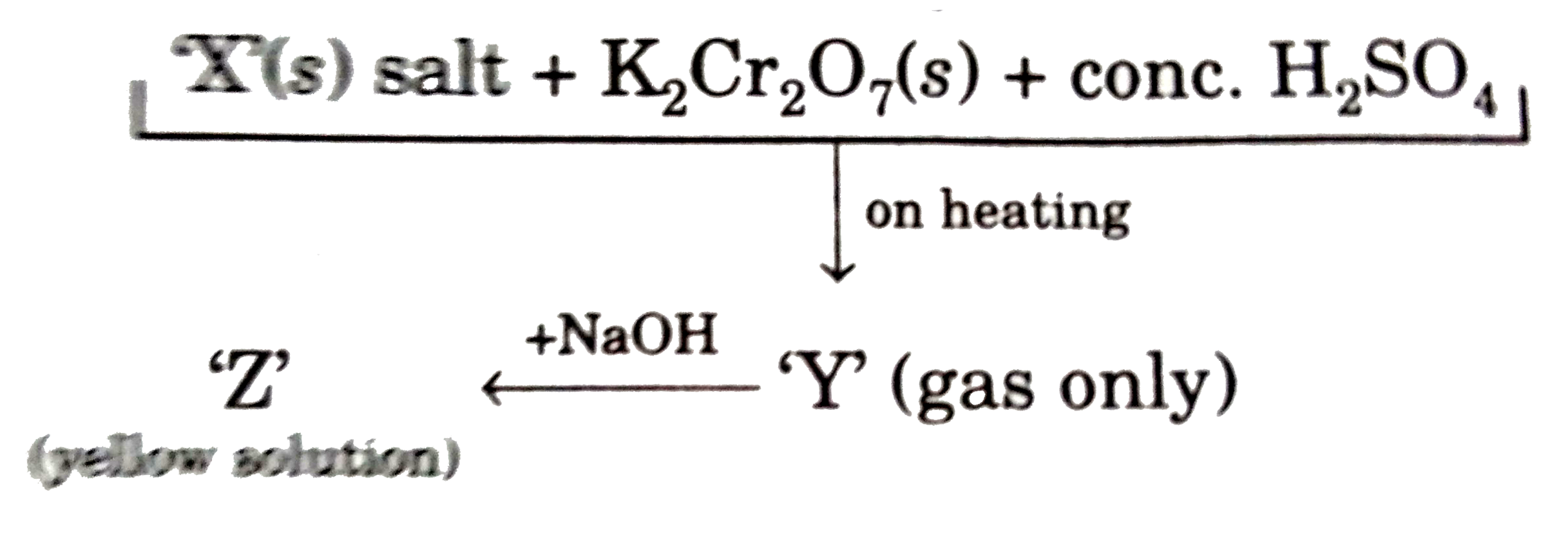
The difference in oxidation state between central metal atom of 'Y' and 'Z' are:
View SolutionAmong the following total number of compounds, which give(s) white precipitate with calcium chloride solution:
`Na_(2)S_(2)O_(3), Na_(2)CO_(3), Na_(2)C_(2)O_(4),NaBr,NaI`
View SolutionThe total number of reagents(s) which give white precipitate with solution of sodium oxalates.
`(MnO_(2)+H_(2)SO_(4)),CaCI_(2),AgNO_(3),BaCI_(2),KMnO_(4),(K_(2)Cr_(2)O_(7)+H_(2)SO_(4))`
View SolutionAmong the following, total number of anions, which decolourises the potassium peramagnate solution in acidic medium
`C_(2)O_(4)^(2-), NO_(2)^(-), (BaCI_(2)+SO_(4)^(2-)), S_(2)O_(3)^(2-), NO_(3)^(-)`
View SolutionAmong the following, the total number of ions that form a precipitate with `Na_(2)HPO_(4)` in ammonical medium.
`Fe^(3+),Mn^(2+),AI^(3+),Mg^(2+),Ba^(2+)`
View Solution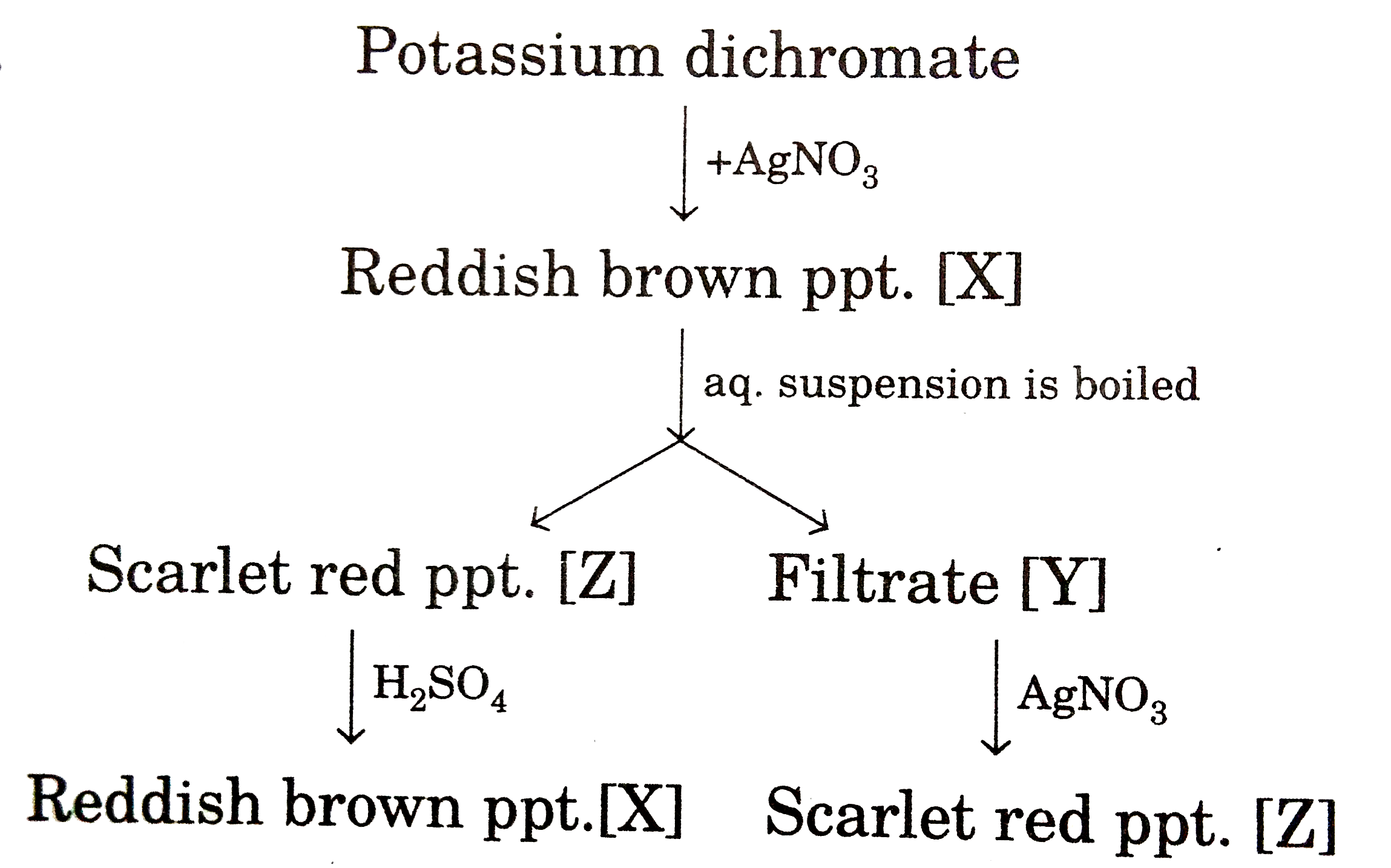
The maximum difference in oxidation state of central atom of anionic part between [Y] and [Z] is:
View SolutionUnder ambient conditions the total number of gases released as other products in the first step of the reaction scheme shown below is:
`{:(KMnO_(4)overset("strongly")underset("heated")rarrP+"other product"),(" "darr"disproportionation in" H^(+)//H_(2)O),(" ""Product(s)"):}`
View SolutionReagent 'X' dissolves `AgCI` precipitate to form a soluble complex 'Y'. On passing `H_(2)S` gas through Y, a black precipitate is obtained. Find the number of possibilities of 'X' from the following reagents.
`KCN`, conc. `HCI, Na_(2)S_(2)O_(3),NH_(3), dil. HNO_(3)`
View SolutionFind out the total number of compounds, which can be dissolved by both dil. `HNO_(3)` and `NaOH`
`PbSO_(3), [PbCO_(3).Pb(OH)_(2)], PbCrO_(4), AgCI, Ag_(3)S, Ag_(2)O`
View SolutionAmong the following, total numbe of reagent(s) which gives yellow precipitate with ammonium chloride solution.
`Na_(3)[Co(NO_(2))_(6)], H_(2)[PtCI_(6)], (NaH.C_(4)H_(4)O_(6)), NaCIO_(4), NaOH`
View SolutionAmong the following, total number of cations that tend to form soluble complex with excess `NH_(4)OH(aq)` and excess `NaCN(aq):`
`Pb^(2+), Cd^(2+), Hg^(2+), Bi^(3+), Cu^(2+), Ag^(+)`
View SolutionAmong the following fin out the total number of black metal sulphides.
`CuS, NiS, CoS, ZnS, CdS`
View SolutionFind the number of reagents in which `Ag_(2)S` is insoluble. hot conc.`HNO_(3), (NH_(4))_(2)S, NH_(3),KCN, Na_(2)S_(2)O_(3)`
View SolutionAmong the following, total number of compound(s) which reduce(s) the yellow solution of `FeCI_(3)` are:
`{:("Tin(II)chloride",,"potassium iodide",),("hydroxylamine",,"hydrazine sulphate",),("ascorbic acid",,"hydrogen sulphide",),("sulphur dioxide",,"potassium dichromate",),("conc.nitric acid",):}`
View SolutionFind out the total number of reagents(s) which converts chromium (III) ion to chromate ion.
`{:(H_(2)O_(2)"solution",,(NaBO_(3).4H_(2)O+H_(2)O_(2)),),(NaOBr,,FeSO_(4),),(NaOH,,K_(2)S_(2)O_(8)):}`
View SolutionHow many reagents are used to identify chromium after oxidation to chromate ion?
`BaCI_(2)," "CaCI_(2),`
(acidified `H_(2)O_(2)`-amyl alcohol), `AgNO_(3)`
View Solution
Subjective Type questions and complete solutions for chapter SALT ANALYSIS of GRB CHEMISTRY (HINGLISH) of Class 11
All Exercises from GRB PUBLICATION Class 11 CHEMISTRY SALT ANALYSIS
- A. Experimental (Laboratory/Apparatus Based)
- B. Dry Tests/Colour/Solubility/Heating Effects
- C.Class- A Subgroup-I-Acidic Radicals
- Comprehension
- Comprehension 1
- Comprehension 10
- Comprehension 11
- Comprehension 12
- Comprehension 13
- Comprehension 14
- Comprehension 15
- Comprehension 16
- Comprehension 17
- Comprehension 18
- Comprehension 19
- Comprehension 2
- Comprehension 20
- Comprehension 21
- Comprehension 22
- Comprehension 23
- Comprehension 24
- Comprehension 25
- Comprehension 26
- Comprehension 27
- Comprehension 28
- Comprehension 29
- Comprehension 3
- Comprehension 30
- Comprehension 31
- Comprehension 32
- Comprehension 33
- Comprehension 34
- Comprehension 35
- Comprehension 36
- Comprehension 37
- Comprehension 38
- Comprehension 39
- Comprehension 4
- Comprehension 40
- Comprehension 41
- Comprehension 42
- Comprehension 43
- Comprehension 44
- Comprehension 45
- Comprehension 46
- Comprehension 47
- Comprehension 48
- Comprehension 49
- Comprehension 5
- Comprehension 50
- Comprehension 51
- Comprehension 52
- Comprehension 53
- Comprehension 54
- Comprehension 55
- Comprehension 56
- Comprehension 57
- Comprehension 58
- Comprehension 59
- Comprehension 6
- Comprehension 7
- Comprehension 8
- Comprehension 9
- D.Class-A Subgroup-II Acidic Radicals
- E.Precipitation/Redox Reacttions
- F.Zero Group Cations
- G: Ist Group Cations
- H: IInd Group Cations
- I. IIIrd Group Cations
- J: IVth Group Cations
- K: Vth and Vth Group Cations
- L: Miscellaneous
- Match The Column Type
- Multiple Objective Type
- Reasoning Type
- Subjective Type